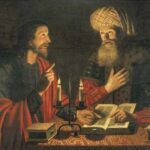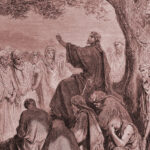The Gospel According to Dan Brown
With over 40 million copies sold worldwide, translated into 44 languages, and a blockbuster film due out in mid-May, The Da Vinci Code has made Dan Brown a very wealthy man. But a whirlwind of controversy has surrounded his novel, first released in March 2003. “Why all the fuss over a work of fiction?” some might ask. The fuss involves the subject matter of the book, and claims made about it.
The Da Vinci Code is about the most important person in history, Jesus Christ, and Dan Brown claims that his book is based on fact. That is where the problems arise.
Very briefly, the book contains two main plot lines. The first is that Jesus was married to Mary Magdalene, had a daughter, and that the Holy Grail is actually the royal bloodline of Mary, still in existence today in Europe. Moreover, Jesus intended that Mary be the head of the church and that we should worship the “divine feminine”. But patriarchal control and power struggles prevented this original intention.
The second plot line is that this story was covered up by the Catholic church, and the main characters in the book seek to unearth this conspiracy and get the truth out about Jesus and Mary. A number of claims are made about this big church cover up, including:
- the idea that belief in the divinity of Christ was a later invention of the church;
- the church has suppressed the real story about Jesus;
- it has also suppressed numerous other “gospels”;
- Mary, rather than Peter, was meant to have led the church;
- the Emperor Constantine in the third century converted matriarchal paganism to patriarchal Christianity;
- a secret society known as the Priory of Sion still worships Mary as a goddess and is trying to keep the “truth” alive;
- Leonardo da Vinci tried to protect these “truths” by planting secret codes in his paintings, especially his painting of the Last Supper.
In addition, the book makes other outrageous claims, such as, all religions are based on fabrication; the Bible is just a fabricated and unreliable book; and there is nothing new about Christianity, only a retelling of old pagan mythology.
All of these claims of massive church cover-ups are simple fantasy, and the various anti-Christian allegations are wildly speculative and lacking in credible evidence. But because Brown claims that his work of fiction is firmly built on fact and solid research, these claims are all the more troublesome. How many countless individuals have been deceived by these erroneous claims? How many people have left the faith because of such wild assertions?
The truth is, this book is one big hatchet job. There are so many major as well as minor inaccuracies, falsehoods, errors and mistakes in this book that a book length expose is required (see the booklist below). There are historical errors, theological errors, errors of art and archeology, to name but a few. Here only a brief critique can be offered of this seriously marred book.
Jesus: Mere Man or God Incarnate?
Perhaps one of the most damning assertions of Brown (speaking through his novel) is the claim that neither Jesus nor the early church believed that Jesus was anything other than a mere mortal. Instead, his claims to deity were invented much later (in 325 A.D.). Thus a massive conspiracy to write history was undertaken, and a new Jesus emerged. And we are still being duped today. Brown makes these claims quite clear when he says, through his character Teabing: “almost everything our fathers taught us about Christ is false”.
According to Brown, Jesus himself never claimed to be divine. And the early church did not teach his deity. It was only at the Council of Nicea in 325 that Emperor Constantine invented the idea of the deity of Christ in order to solidify his power. As these claims directly challenge core Christian beliefs, they deserve some attention here.
Contrary to Brown, both Jesus and the early disciples asserted boldly that Jesus was not just a human prophet, but indeed God with us. Jesus himself asserted his belief in his equality with the Father in numerous places. “I and my Father are one” he could say (John 10:30). He told Philip that “anyone who has seen me has seen the Father” (John 12:44).
He claimed attributes (and performed actions) consistent with divinity, including forgiving sins, predicting his death and resurrection, and announcing his role as judge of all things at the end of time.
The Jews at the time certainly understood where he was coming from: they sought to kill him, for in claiming God as his father, he was “making himself equal with God” (John 5:18). While the Romans wanted him dead for being a threat to the peace, the Jews wanted him dead for his religious claims which they regarded as blasphemy.
His earliest followers also proclaimed his full deity. The first verse of John’s gospel proclaims that “the Word [Jesus] was God”. Paul, writing a few decades after the death of Christ, could speak of Jesus as “being in the very nature of God” (Phil. 2:6) and being “the image of the invisible God” (Col. 1:15-16). Other New testament writers make similar claims about Jesus. Even doubting Thomas could exclaim as he fell at the feet of Jesus: “my Lord and my God” (John 20:28).
Jesus continually accepted the worship of his followers, not just by Thomas but by many others (blind men, wise men, lepers, Mary Magdalene, rulers, angels, and his disciples. Both he and they were well aware that only God alone could be worshipped (Ex. 34:14; Deut. 6:13; Matt. 4:10).
And the early church followed suit. For example, many second century church fathers continued this tradition, clearly proclaiming the deity of Christ, including Polycarp, Ireanaeus, Clement, Tertullian, and Justin Martyr. In addition, the willingness of countless followers of Christ to be tortured and go to their deaths was certainly not based on the idea that this man was just another teacher, a mere human prophet. They were convinced that this was God in the flesh, and they worshipped him as they worshipped God.
Thus the idea that the full deity of Christ first arose in 325 is sheer nonsense. Both the New testament and early church history give lie to this claim. Nicea simply affirmed the long standing belief that Jesus was the Messiah, the son of God, and the object of his followers’ worship and devotion.
Constantine and Nicea
Brown presents all sorts of misinformation when he discusses Constantine and the Council of Nicea. Contrary to Brown, Constantine did not collate the Bible as we know it today. Recognition of the New testament canon was an evolving affair, but already by the second century AD there was a pretty clear understanding as to which books were authoritative and which were not.
The canon, in other words, was not imposed from the top but recognized from below. The church never created the canon, it simply recognized it. And by the time of Constantine this process was pretty well complete.
Moreover, the idea that Constantine changed Scripture, by creating a new Bible, while suppressing the old one, is ludicrous. There would have been thousands of copies of Scripture circulating at this time. Does any one seriously believe he managed to track down every single copy of the original version of Scripture, destroy them, and then circulate his new improved version? Talk about the greatest cover up in history! This Constantine must have had superhuman powers to carry out such a feat.
And what of the claim that the deity of Christ was here for the first time advanced? As was just mentioned, the church from day one proclaimed the deity of Christ. What the Council of Nicea did at this time was to refute the heresy of Arianism (which denied that Jesus was co-eternal with the Father, but was in fact the first being created by God).
This was done by writing a creed to challenge the Arian writings, and this in turn became the blueprint for the Nicean Creed. The Creed merely formulates what had been held to for several centuries: “We believe in one Lord, Jesus Christ, the only Son of God, eternally begotten of the Father, God from God, Light from Light, true God from true God, begotten, not made, of one Being with the Father; through him all things were made.”
Moreover, contrary to Brown’s assertion that this was done by a very close vote of the Bishops present, the reality is quite the opposite. Of the over 300 Bishops assembled to discuss Christ’s deity, in the end only two did not vote for the new creed. Hardly a close vote.
Constantine and the assembled Bishops did not revise history or rewrite history, as Brown so cavalierly asserts. They affirmed what had been common teaching for three centuries. There were no new ideas invented here: simply the formulation and clarification of long-standing beliefs, which go back to the very sayings of Jesus.
Gnostic nonsense
What about the Gnostic gospels, like the Gospel of Thomas, which Brown is so enamoured with? Quite simply, these gospels, while of some cultural and historical interest, offer us little of theological value. And their claims about Jesus and the early church are strictly of limited value.
Indeed, these gospels do not contain eye-witness accounts of the life of Jesus, as the New Testament Gospels do, nor were they written soon after the life of Christ. The earliest of these gospels were written at least one and a half centuries after the events described in the canonical gospels. Matthew, Mark, Luke and John, on the other hand, were written just decades after the death of Jesus. (Many scholars believe all four were written before 70 A.D., when Jerusalem and its temple were destroyed, since none of them mention this event.)
A general rule of thumb in historiography is the earlier the better. If we have two sets of accounts, a first hand account of an event, and accounts which were written several centuries later, the earlier accounts are generally deemed to be the most trust-worthy and most reliable.
Moreover, while Brown claims there were “more than eighty” of these alternate gospels making the rounds, the truth is much different. Fewer than twenty actual stories of the life of Jesus (or gospels) exist, and these mainly date one and a half to three centuries after Jesus’ life on earth.
He also claims that only four gospels were accepted while the rest (of the supposed 80 plus) were rejected. Sorry again, Mr Brown. The four canonical gospels that we know were by the middle of the second century nearly universally accepted. The many other spurious gospels were not even around then, and when they did come on the scene they were generally rejected as spurious. So there is no sinister plot to pick some gospels and reject a host of others.
Moreover, these are called Gnostic writings because they present the Gnostic worldview. Briefly, the Gnostic movement sought to blend Platonic ideas with the early Christian teaching. Gnostic beliefs were varied, but there was an emphasis on secret, hidden knowledge (Greek, gnosis) which only an elite minority could attain to.
Gnostics were dualistic, despising the body and matter while elevating the spirit and the non-physical. Escaping the bondage of the body through special knowledge was the path to salvation for the Gnostics. Biblical Christianity on the other hand affirms the material world. Not only are we created as physical beings, but God himself became flesh (Latin, incarnation). Moreover, we await resurrection bodies, and a new heaven and new earth.
Salvation does not mean fleeing the material world through secret knowledge, but fleeing our sinful self in repentance and resting on the atoning sacrifice of Christ on our behalf. Mere knowledge alone can never save anyone. But knowledge of what Christ has done for us is the first step in reconciliation with God. Thus the early church rightly rejected as heresy the various Gnostic writings that appeared.
One strange fact might be noted. Brown seeks to do two contradictory things: establish the legitimacy of the Gnostic writings, and develop a feminist theology, where goddess worship and feminine spirituality (the “sacred feminine”) are said to be the real essence of Christian faith. Yet interestingly, the Gnostic writings as a whole had a very low view of women. Female leadership was out of the question, and even the much vaunted Gospel of Thomas says that females need to become males in order to enter God’s kingdom (find salvation)!
Jesus and Mary
In keeping with Brown’s feminist theology, he has lots to say about Mary. The idea that Jesus married Mary Magdalene and had a child (in France, of all places), is a key theme found in his novel, and to some, it may sound tempting. But the problem is, we do not have a scarp of evidence to confirm this. Such ideas certainly cannot be found in the New Testament. And those spurious gospels that purport to mention it, such as the Gospel of Philip and the Gospel of Mary, are unreliable at best.
For example, Brown appeals to the Gospel of Philip, a third century document, to make his case for marriage. But there are a number of problems here (as there are with most contentions Brown makes). Several crucial words are missing in the relevant passages of the original documents, so we cannot be fully sure what Philip is getting at. And even if the gospel speaks of Jesus kissing Mary, this is hardly a case for marriage. There is, after all, a kiss of fellowship, mentioned often in the New Testament.
Moreover, he claims the word ‘companion’ used here stands for marriage, when in fact it most likely refers to friendship. Finally, he is wrong to suggest this is an Aramaic document, when it is actually Coptic. But such sloppy thinking is found throughout this novel. It is third rate scholarship applied to a fourth-rate thesis.
But Brown argues that it is very unlikely for a Jewish male during this period to remain unmarried. Several things can be mentioned here. First, we simply have no evidence whatsoever that Jesus was ever married. Second, even liberal biblical scholars agree that Jesus was most likely single. Third, while singleness was the exception in Jesus’ day, that does not rule out Jesus being unmarried. Fourth, many other great prophets, such as Jeremiah and John the Baptist, were not married. Fifth, even if he were married, it would in no way impugn his claims to deity, as critics allege.
Other points of evidence could be produced. For example in 1 Corinthians 9, Paul defends the right of the apostles to be married, and cites Peter and the brothers of Jesus. If Jesus were married, he could have clinched his argument by citing Jesus. But he does not.
Suffice it to say then that this major premise of The Da Vinci Code is not supported by a shred of evidence anywhere.
Conclusion
In truth, the Da Vinci Code is one long (454 page) attack on Christianity, especially in its Catholic version. The very core truths of the Christian faith are here assaulted, and a fast-paced work of fiction based on conspiracy theories involving sex, power and religion are used to convey an anti-Christian agenda. Because it claims to be based on fact, even though it is a work of fiction, many people are being deceived as to the true claims of Christianity, actual church history, and current biblical scholarship.
[2598 words]
For Further Reading
Evangelical Protestant Critiques
Abanes, Richard, The Truth Behind the Da Vinci Code: A Challenging Response to the Bestselling Novel. Harvest House, 2004.
Boa, Kenneth and John Turner, The Gospel According to the Da Vinci Code: The Truth Behind the Writings of Dan Brown. Broadman and Holman, 2006.
Bock, Darrell, Breaking The Da Vinci Code : Answers to the Questions Everybody’s Asking. Nelson Books, 2004.Flory, Susanna and Virginia Monroe, Fear Not Da Vinci: Using the Da Vinci Code to Share Your Faith. AMG, 2006.
Clark, Stephen, The Da Vinci Code on Trial. Evangelical Press, 2005.
Garlow, James, Cracking Da Vinci’s Code: You’ve Read the Fiction, Now Read the Facts. Faithworks, 2004.
Garlow, James, The Da Vinci Codebreaker: An Easy-to-Use Fact Checker. Bethany House, 2006.
Green, Michael, The Books the Church Suppressed. Monarch, 2005.
Gumbel, Nicky, The Da Vince Code: A Response. Alpha International, 2005.
Hanegraaff, Hank and Paul L. Maier, The Da Vinci Code: Fact or Fiction. Tyndale House, 2004.
Lutzer, Erwin W., The Da Vinci Deception. Tyndale House, 2004.
Strobel, Lee and Garry Poole, Discussing the Da Vinci Code. Zondervan, 2006.
Witherington, Ben, The Gospel Code. IVP, 2004.
Catholic Critiques
Kellmeyer, Steve, Fact and Fiction in The Da Vinci Code. Bridegroom Press, 2004.
Mobbs, Frank, The Incredible Da Vinci Code. Freedom Publishing, 2005.
Olson, Carl E. and Sandra Miesel, The Da Vinci Hoax: Exposing the Errors in The Da Vinci Code. Ignatius Press, 2004.
Thompson, Mary, Mary of Magdala: What the Da Vinci Code Misses. Paulist Press, 2005.
Welborn, Amy, De-Coding Da Vinci: The Facts Behind the Fiction of The Da Vinci Code. Our Sunday Visitor, 2004.
Other Critiques
Ehrman, Bart, Truth or Fiction in the Da Vinci Code: A Historian Reveals What We Really Know about Jesus, Mary Magdalene, and Constantine. Oxford University Press, 2006.




















Well done sir. If only Dan Brown and those like him were remotely interested in the concept of hard evidence! But of course they’re not, which is why they show such unfaltering contempt for it. Nor are they interested in originality, however perverse. Everything Dan Brown peddles has been condemned by orthodox churchmen since Athanasius’s time, at least.
RJ Stove, Melbourne
If a fiction could move a person’s faith, then I would say the faith is not genuine. The Lord will also seperate the sheep from the goat. In the last days Satan will come and deceive, this work, the Da Vinci Code, is one of the kind.
James Wang
Good work, Bill. I just read the book and knew much of it was fantasy, but yet his claim at the beginning that some things were fact threw me a bit. Thanks for your clear explanation and helping me sort it out. I’m glad you finally have a blog!
Terry, The Netherlands
Many thanks Bill. A concise response to any who have, or are likely to be, deceived by Brown’s diatribe – and they are numerous. I trust you will be happy to have this circulated as widely as possible.
Keep up the good work.
Pat Healy, Hamilton, VIC
Dear Bill,
I read this book because friends were coming up with very strange ideas about Jesus and I needed to know what it was about. As a mystery story it was interesting, but as someone who has great faith in the bible and Jesus’ role in our salvation, I was horrified at the way He was being portrayed. I had resisted the idea of seeing the film as the book had been so unsettling, but I might go so I can be informed about it and can talk to people about it.
As God always brings out good from bad situations, I feel sure that this will happen here and I hope it is soon.l
Glad to see your website underway.
Anne Darbyshire, Melbourne
Excellent summary article pointing out the flaws in Brown’s novel. Interesting that even though it is a novel, that is fictional, many believe that it is based in truth. Understanding some of the facts Bill has presented undermines the whole book. After having discussions with a whole range of Christian folk I know many who won’t read the book or see the film. I think we need to do both in order to be able to effectively argue against it, and engage with the culture of our day. Let’s use this opportunity to share the real truth with others who may be searching.
Russell Stubbings, Melbourne
Bill,
Many thanks for your article, re The Da Vinci Code. We appreciate your insights into this and many other subjects.
Regards L & N Mitchell, Melbourne
Dear Bill
Many thanks for keeping us in touch with many current issues such as The Da Vinci Code, both on your web site and in other ways.
I especially appreciate your very positive attitude, that with The Da Vinci Code we have an excellent opportunity to share the truth about Jesus to our friends and contacts. You help so much by giving us easy to access and clear information. And thank you for challenging us out of our “comfort zones” to do something positive.
May God continue to bless your ministry.
Sincerely, Alison Ferguson, Hobart
Dear Bill
Well said. Clearly and insightfully explained.
This will help me share with my friends about the real and whole “Truth” – Jesus – as they ask lots of ‘currently’ hot questions!
Many thanks.
Kerryn Zwag, Wantirna
Dear Bill,
I think your website is very good.
With the “Da Vinci Code” movie set to be released in the country on Thursday May 18th, I believe it is important that we circulate information to as many people as we can to dissuade them from seeing the movie, to prevent non-Christian people getting a grossly distorted view of Christ and the Church, or allowing this movie to weaken the faith of some Christians in our community. There are many good websites, books and sources of information which can be used to discredit the ideas of “The Da Vinci Code” without having to see the movie for yourself.
People need to be aware that if they go to see this movie, they are financially supporting those who have insulted our Lord and attacked the Church.
Are we for our Lord Jesus or against Him?
“If anyone declares publicly that he belongs to me, I will do the same for him before my Father in heaven. But if anyone rejects me publicly, I will reject him before my Father in heaven.” Matthew 10: 32-33.
Michael Palma, Hampton Park, Victoria
Dear Bill, Thank you so much for all the wonderful research and study that you so graciously share with others. It is most helpful and a great support to the Christian Worldview. Christian greetings,
Dawn McGregor, Buderim
Startling fiction
Dan Brown’s book The Da Vinci Code claims in the beginning “All descriptions of artwork, architecture, documents and secret rituals in this novel are accurate.”
Dan’s novel is in the genre of fiction; the oxford dictionary meaning of fiction is not real; not genuine; imaginary.
Besides Dan Brown’s erroneous claims about Christianity; church history; and current biblical scholarship [as Bill has so kindly shared with us about here], the reader’s intelligence is further insulted by current and historical flawed ‘facts’.
Dan states the Dead Sea Scrolls were found in the 1950’s instead of 1947, and these scrolls state nothing about the early Christians, as he suggests.
Dan states the glass pyramid at the Louvre (Paris) has 666 glass panes, but it has 673.
Any child could conduct research on the internet to view these simple facts (as I did).
Mo Tzu (China, 479-381 BCE) is quoted as saying, “The task of the human-hearted man is to procure benefits for the world and to eliminate its calamities. Now among all the current calamities of the world, which are the greatest?…(the) deception of the simple by the cunning…”
A person will be remembered by the things he says and does. I ask myself, why does Dan publish lies? Was it to cause division among men? Advertise his madness? Or both of the above and make money in the process? Well Dan has achieved all that and more.
Michael Dawson, Melbourne
Well done
Dan Brown has not even used his own creativity, but has ‘liberated’ most of the details from other fictional books.
He has also takem some of the mythology of the freemasons order of ‘The knight Templar” and ‘Rose Croix’.
Now that I am Saved; I can see through all the Masonic, and Dan Brown rubbish. What I pray for is that this will not be a stumbling block for those who are seeking God.
Hiram Abiff
I also pray for Dan Brown; as he will have to give account for his deception on the day of reckoning.
The Da Vinci Code is yet another pitiful, yet very damaging symptom of a highly disturbing trend, presently afflicting contemporary western society, pointed out, quite succinctly, by Professor Howard S. Schwartz of Oakland University, Rochester, Michigan, USA.
“I have no doubt that, someday, the distortion of the truth by the radical feminists of our time will be seen to have been the greatest intellectual crime of the second half of the twentieth century. At the present time, however, we still live under the aegis of that crime, and calling attention to it is an act of great moral courage” – ‘Revolt of the Primitive’ – 2001.
Dan Brown is just one of a very long line of people who, throughout history, have ruthlessly exploited, for personal gain, the hatred and extremism that is the zeitgeist of their time.
A read of the wisdom and truth that abounds within the work of C.S. Lewis would answer anything that Dan Brown had to say. But anybody of reasonable intelligence should be able to crack the ‘Dan Brown Code’ quite easily by themselves. It requires little imagination and is a very simple one based upon greed and subservience to secular, left wing, feminist extremism.
Peter Charnley, UK
Very helpful article with useful references. I’ve linked it on our site’s Q&A page on Jesus Christ.
Jonathan Sarfati, Brisbane